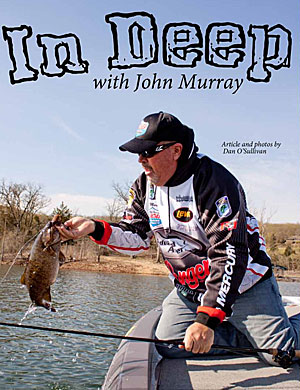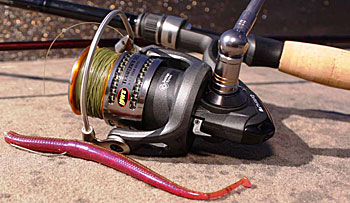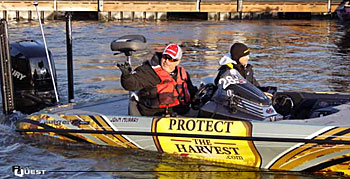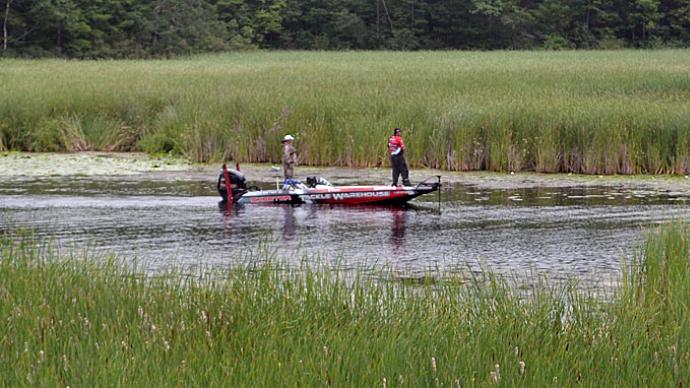
Phoenix, Arizona-based tour pro John Murray is a self-avowed deep structure angler. His passion for finding offshore fish is so strong that he will do everything he can to find schools of fish that are relatively unmolested, as deep as he can find them.
From his earliest days as an angler, Murray has been known for his strength in topwater fishing and finesse fishing in deep water.
But as any good angler does, Murray learned to adapt his pure light line skills from his western days to his newfound playing grounds of the east once he made that leap.
Like any other pro, Murray knows he has to be proficient in presenting the lure correctly and locating bass first, something he has done well throughout his career. “I work to find the fish that I think nobody else will find,” he said. “Once I do, I try to give them something that I know will produce bites, and this time of the year, I have three fallbacks that I use regularly.”
Of course, he will throw a crankbait in the proper settings, but when the conditions are not prime for the aggressive reaction presentation, he continues to produce results by toning it down a bit. However, any good bass fishing success story begins with the search.
Finding Hidden Gems
A loner of sorts on the water, Murray tries to keep himself out of the middle of the combat fishing scene. As a result, his research periods find him looking for obscure fishing holes. Once he arrives at a lake, he launches his Ranger/Mercury rig and immediately begins scanning his depth finders, looking for “the activity zone.”

“I look to see the depth zone that the baitfish are active at on my screens while I’m idling out of the marina,” he said. “It can be pretty obvious what depth level the baitfish are using because you will see bait bands on your screen, especially this time of the year. I use that information to search for the structure I want to fish.”
Murray said that once you locate that depth zone, the baitfish in most of the lake will find that same level to be within their comfort zone. Of course, there are resident fish in shallow water that feed on bluegill and other creatures, but he likes to locate this zone because he is looking for schools.
Once he does, he opens up his mapping and looks for a structure that intersects slightly above and below that level. If the baitfish show themselves at 20 feet, Murray will begin looking for a structure that tops out at 5 to 10 feet above or below that level. He said you’d have to do a little math to compensate for the water level, but he looks for structure in that zone.
Not just any structure either; “I want the most isolated piece of structure I can find at that level,” he said. “The longest point, the lone hump in that range with deep water all around - that’s the type that bass will have to congregate on because it is also the only thing around for them to relate to.” They can also suspend at the level just off of structure elements, and if that’s what he comes across, he will adjust his presentations.
Big Favorites for Going Deep
The adaptations Murray has made for his offshore fishing from the west to the east have revolved around the lures he has used to draw strikes. Where deep structure required a light line on the left coast, he found he could beef things up in the rest of the country. With that in mind, he could leave the split shot rigs and vertical jigging spoons alone and turn to jigs and creatures - most of the time. He does have one little western twist as his backup for tough times.

In ideal conditions, Murray said he prefers to use a football head jig and a trailer, or if the fish are slightly more aggressive, he turns to scoot a creature bait across the bottom.
His first choice is a jig of his design: the Papa Mur Jig by River2Sea, a football jig with a uniquely designed hook for proper rigging of trailers and holding hooked fish. He prefers to use the 7/8-ounce size for deeper water, and he chooses colors according to the water clarity.
He likes green pumpkins, watermelons, brown-based colors for clear water, and black for dirtier water.
He also matches trailers according to the behavior of the bass. He tips his jig with a Gene Larew Salt Craw if the bass are sluggish. If they are aggressively moving through the schools of bait, he will opt for a Gene Larew Rattlin’ Crawl’R. And if they are in between, the Gene Larew Hoo Daddy Jr.’s swimming tails are a hit.
If the bass are active, he makes short hops along the bottom, allowing the trailer to create action and causing the fish to strike. If they are sluggish, he employs a stroking technique that lifts the lure three to six feet off the bottom, allowing it to fall quickly on a semi-slack line, causing bass to respond reflexively.
If the fish are holding to the bottom, he turns to an 11/16-ounce Gene Larew Hardhead rigged with a Gene Larew Biffle Bug, which he scoots along the bottom, allowing the head to beat the rocks, creating reaction strikes.
He rigs both the Papa Mur jig and the Biffle Bug set up on a 7’4” heavy action Team Lew’s rod with a Lew’s Team Pro reel with a 6.4:1 retrieve speed. He spools 15 to 17-pound-test Toray Superhard Premium Plus Hi-Grade Fluorocarbon line for the Papa Mur Jig, which he upgrades to 17 to 20 pound-test of the same brand of the line for the Biffle Bug, depending on the depth and severity of the rocks on the bottom.
Deep Finesse Backup

If the bite is tough or the fish are suspended, he will use a dropshot rig, a technique he still employs from his western days and has the utmost confidence in. “If the fish are suspended or finicky, I turn to a dropshot rig,” he said. “Some guys like a shaky head, but I land more fish with the dropshot, so I use it.”
He rigs a 7’ medium-heavy Team Lew’s spinning rod and Team Lew’s Gold size
3000 spinning reel with 30-pound-test Toray Bawo Finesse Braid with a 6 to 8-pound-test leader Toray Bawo Fluorocarbon. He ties a 1/0 Rebarb style finesse hook and a 3/16 to 3/8-ounce River2Sea Tungsten Tear Drop sinker to the line, then affixes his Gene Larew TattleTail worm to the hook.
“I can pull this bait along the bottom and let the little tail give vibration off, or I can shake it vertically and let the tail dance for suspended fish,” he said. “The one thing I am careful to do is not overwork the dropshot rig. These fish are spooky, and unnatural actions can make them not bite. I try not to shake the rod too much. Just let the natural action of the waves provide the action.”
Wrapping Up Murray left us by giving us a final piece of advice. “Try to find the most obscure structure you can locate, and give a couple of these techniques a try,” he said. “I’ve been using them to catch fish for years, and with some of the newer tools at my disposal now, I’ve been able to produce some great results."
Republished with permission by





